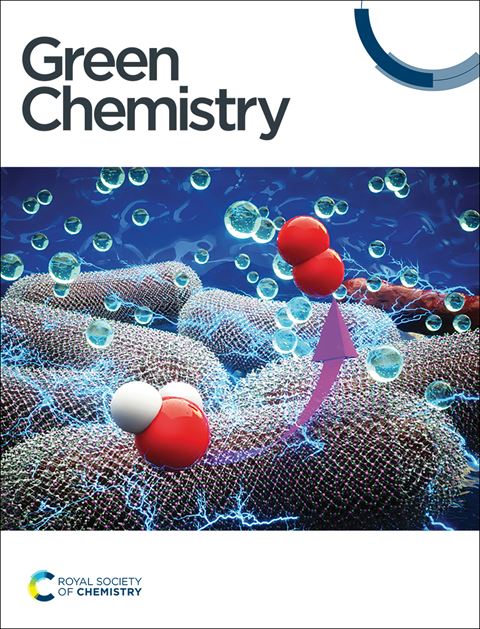Regulating the bubble-water/catalyst interface microenvironment for accelerated electrosynthesis of H2O2via optimizing oxygen functional groups on carbon black†
IF 9.3
1区 化学
Q1 CHEMISTRY, MULTIDISCIPLINARY
引用次数: 0
Abstract
The selective electrosynthesis of hydrogen peroxide (H2O2) via the oxygen reduction reaction (ORR) holds significant promise for sustainable chemical production. In this study, we optimized the oxygen functional groups on carbon black (CB) to modulate the bubble-water/catalyst interface microenvironment, thereby enhancing the electrosynthesis of H2O2. A simple hydrothermal method was employed to functionalize the carbon black surface, and the oxygen content was systematically adjusted by varying the temperature and time. The electrochemical performance of the resulting catalysts was evaluated, with CB-85-6 h demonstrating the highest H2O2 productivity (3302.23 mmol gcat−1 h−1) and selectivity (90.1%). EDS, XPS, Raman spectroscopy, and contact angle analysis demonstrated that the introduction of oxygen functional groups enhanced the surface hydrophobicity, facilitating the adsorption and activation of oxygen. Density functional theory (DFT) calculations further confirmed that the COOH at the edge of graphene, C–O–C at the basal 2 and CO at the edge optimize the binding energy of the reaction intermediates, improving both the selectivity and efficiency of H2O2 production. This work provides valuable insights into the design of highly efficient catalysts for electrocatalytic H2O2 synthesis.

通过优化炭黑†上的氧官能团调节气泡-水/催化剂界面微环境以加速h2o2的电合成
通过氧还原反应(ORR)选择性电合成过氧化氢(H2O2)为可持续化工生产带来了巨大的希望。在本研究中,我们通过优化炭黑(CB)上的氧官能团来调节气泡-水/催化剂界面微环境,从而增强H2O2的电合成。采用简单的水热法对炭黑表面进行功能化,并通过改变温度和时间来系统地调节氧含量。结果表明,CB-85-6 h催化剂的H2O2产率最高(3302.23 mmol gcat−1 h−1),选择性最高(90.1%)。EDS, XPS,拉曼光谱和接触角分析表明,氧官能团的引入增强了表面疏水性,有利于氧的吸附和活化。密度泛函理论(DFT)计算进一步证实,石墨烯边缘的COOH、基底2的C-O-C和边缘的CO优化了反应中间体的结合能,提高了H2O2生成的选择性和效率。这项工作为设计高效的电催化合成H2O2催化剂提供了有价值的见解。
本文章由计算机程序翻译,如有差异,请以英文原文为准。
求助全文
约1分钟内获得全文
求助全文
来源期刊

Green Chemistry
化学-化学综合
CiteScore
16.10
自引率
7.10%
发文量
677
审稿时长
1.4 months
期刊介绍:
Green Chemistry is a journal that provides a unique forum for the publication of innovative research on the development of alternative green and sustainable technologies. The scope of Green Chemistry is based on the definition proposed by Anastas and Warner (Green Chemistry: Theory and Practice, P T Anastas and J C Warner, Oxford University Press, Oxford, 1998), which defines green chemistry as the utilisation of a set of principles that reduces or eliminates the use or generation of hazardous substances in the design, manufacture and application of chemical products. Green Chemistry aims to reduce the environmental impact of the chemical enterprise by developing a technology base that is inherently non-toxic to living things and the environment. The journal welcomes submissions on all aspects of research relating to this endeavor and publishes original and significant cutting-edge research that is likely to be of wide general appeal. For a work to be published, it must present a significant advance in green chemistry, including a comparison with existing methods and a demonstration of advantages over those methods.
 求助内容:
求助内容: 应助结果提醒方式:
应助结果提醒方式:


